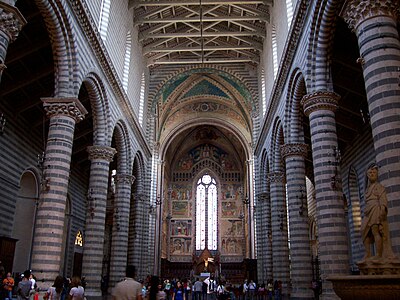Talk:Italian Gothic architecture
| This article is rated Start-class on Wikipedia's content assessment scale. It is of interest to the following WikiProjects: | |||||||||||||||||||||
| |||||||||||||||||||||
Removed from Gothic architecture
[edit]There may be material her which can be incorporated in to the present article
Gothic architecture in Italy
[edit]-
Siena Cathedral (1215–1263)
-
Interior of Siena Cathedral (1215–1263)
-
Orvieto Cathedral (1290–1591)
-
Nave of Orvieto Cathedral (begun 1290)
-
Pulpit of Pisa Cathedral, by Giovanni Pisano (1302–1310)
-
Santa Maria della Spina (about 1323)
-
Milan Cathedral (1386–1510 – facade from 19th century)
-
Doges Palace (1424–1442)
Italian Gothic architecture went its own particular way, departing from the French model. It was influenced by other styles, notably the Byzantine style introduced in Ravenna. Major examples include Milan Cathedral, the Orvieto Cathedral, and particularly Florence Cathedral, before the addition of the Duomo in the Renaissance.[1]
The Italian style was influenced by the materials available in the different regions; marble was available in great quantities in Tuscany, and was lavishly used in churches; it was scarce in Lombardy, and brick was used instead. But many of the architectural elements were used apparently mainly to be different from the French style.[2]
The Cistercian monastic order introduced some of the first Gothic churches into Italy, in Fossanova Abbey (consecrated 1208) and the Casamari Abbey (1203–1217). They followed the basic plan of the Gothic Cistercian churches of Burgundy, particularly Cîteaux Abbey.[3]
The Italian plan is usually regular and symmetrical, Italian cathedrals have few and widely spaced columns. The proportions are generally mathematically equilibrated, based on the square and the concept of "armonìa", and except in Venice where they loved flamboyant arches, the arches are almost always equilateral. Italian Gothic cathedrals often retained Romanesque features; the nave of Orvieto Cathedral had Romanesque arches and vaults.
Italian cathedrals also offered a variety of plans; Florence Cathedral (begun 1246) had a rectangular choir, based on the Cistercian model, but was designed to have three wings with polygonal chapels. Italian Gothic cathedrals were generally not as tall as those in France; they rarely used flying buttresses, and generally had only two levels, an arcade and a claire-voie with small windows; but Bologna Cathedral (begun in 1388), rivalled Bourges Cathedral in France in height. The smallest notable Italian Gothic church is Santa Maria della Spina in Pisa (about 1330), which resembles a Gothic jewel box.[3]
A distinctive characteristic of Italian Gothic is the use of polychrome decoration, both externally as marble veneer on the brick façade and internally where the arches are often made of alternating black and white segments. The columns were sometimes painted red, and the walls were decorated with frescoes and the apse with mosaic. Italian cathedral façades are often polychrome and may include mosaics in the lunettes over the doors. The façades have projecting open porches and ocular or wheel windows rather than roses, and do not usually have a tower. The crossing is usually surmounted by a dome. There is often a free-standing tower and baptistery. The eastern end usually has an apse of comparatively low projection. The windows are not as large as in northern Europe and, although stained glass windows are often found, the favourite narrative medium for the interior is the fresco.[4] The facade of Orvieto Cathedral, begun in 1310, is a striking example of mosaic decoration. Another innovation of Italian Gothic is the bronze doorway covered with sculpture; the most famous examples are the doors of the Florence Baptistery by Andrea Pisano (1330–1336).[5]
Italian Gothic cathedrals did not have the elaborate sculptural tympanums over the entrances of French cathedrals, but they had abundant realistic sculptural decoration. Some of the finest work was done by Nicola Pisano at the Pisa Baptistery (1259–60) and in Siena Cathedral, and by his son Giovanni Pisano on the west facade of Pisa Cathedral (1284–85).[6]
A Commons file used on this page or its Wikidata item has been nominated for deletion
[edit]The following Wikimedia Commons file used on this page or its Wikidata item has been nominated for deletion:
Participate in the deletion discussion at the nomination page. —Community Tech bot (talk) 02:54, 18 February 2023 (UTC)
- ^ Ducher 1988, p. 62.
- ^ Martindale 1993, p. 147.
- ^ a b Martindale 1993, p. 148.
- ^ Cite error: The named reference
BFwas invoked but never defined (see the help page). - ^ Martindale 1993, pp. 161–175.
- ^ Martindale 1993, pp. 152–176.










